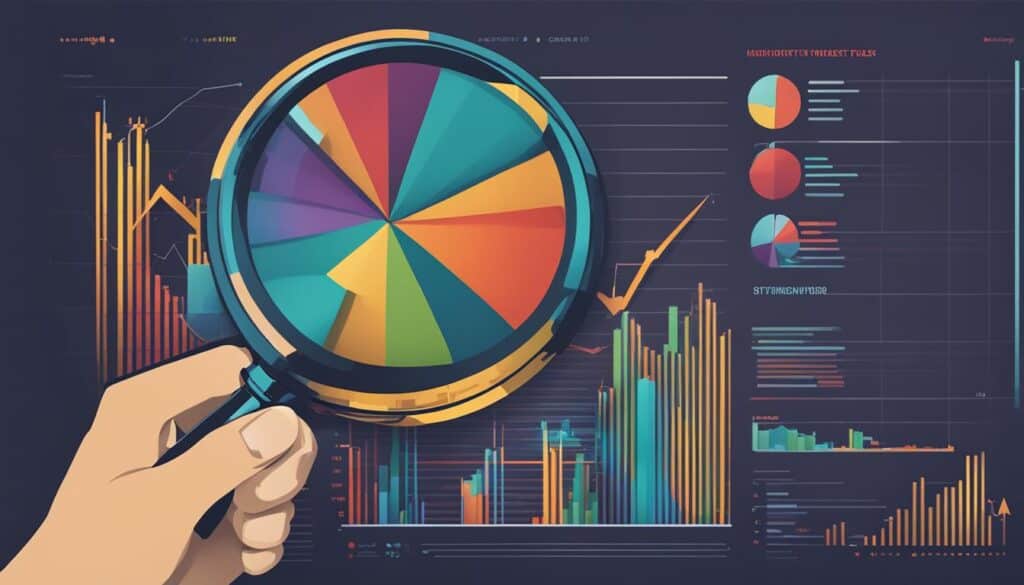Spot market trading can offer lucrative opportunities for traders, but it also carries inherent risks. To navigate these risks and maximize gains, implementing effective risk management strategies is essential. In this article, I will explore various strategies and techniques that traders can use to manage risks effectively in spot market trading.
Key Takeaways:
- Understanding the spot market dynamics is crucial to managing risks effectively.
- Identifying and assessing potential risks is the first step in risk management.
- Diversification and stop-loss orders are important risk mitigation techniques.
- Risk management is an ongoing process that requires continuous monitoring and adjustment.
- By actively managing risks, traders can maximize gains and minimize potential losses.
Understanding the Spot Market
Before diving into risk management strategies, it is important to understand the spot market and its dynamics. The spot market refers to the market where financial instruments, such as currencies, commodities, and securities, are traded for immediate delivery or settlement. Spot market prices are influenced by various factors, including supply and demand dynamics, economic indicators, geopolitical events, and market sentiment. Traders must be aware of these factors and monitor market volatility and price movements to identify potential risks and opportunities.
In the spot market, traders buy or sell assets at the current market price, known as the spot price. Unlike derivatives or futures contracts, spot market transactions involve the immediate transfer of ownership. This makes spot market trading highly responsive to changing market conditions and price movements.
Market volatility plays a significant role in the spot market. Volatility refers to the degree of variation or rapid changes in price over a given period. A highly volatile market can experience large price swings, presenting both opportunities and risks for traders. Traders need to be prepared to navigate volatile market conditions and adapt their strategies accordingly.
“Market volatility provides traders with opportunities to profit from price movements, but it also increases the risk of significant losses. Proper risk management is essential to navigate the spot market successfully.”
Understanding price movements is key to anticipating potential risks in the spot market. Price movements can be influenced by a range of factors, including economic data releases, central bank decisions, geopolitical events, and market sentiment. Traders must closely monitor these factors and analyze price patterns to make informed trading decisions.
By diligently monitoring market volatility and price movements, traders can identify trends, patterns, and potential risks. This information helps them develop effective risk management strategies to protect their capital and maximize their gains in the spot market.
Risk Identification and Assessment
The first step in effective risk management is identifying and assessing potential risks. As traders, it is crucial to conduct a thorough analysis of the market and identify factors that could impact the prices of the instruments we are trading. This includes analyzing historical price data, monitoring market volatility, and staying informed about relevant news and events.
By analyzing historical price data, we can identify patterns and trends that can help us anticipate potential risks. Volatility analysis allows us to understand the degree of price fluctuations in the market, enabling us to gauge the level of risk associated with our trades. It is essential to stay updated with market news and events that may have an impact on the instruments we trade, as they can introduce risks or alter market dynamics.
Once the risks are identified, the next step is to assess their potential impact on our positions and portfolios. By evaluating the probability of occurrence and the potential magnitude of the impact, we can better understand the level of risk exposure. This assessment helps us prioritize and allocate resources effectively to manage the identified risks.
Importance of Risk Identification and Assessment
Risk identification and assessment are crucial components of risk management because they provide us with the foundation to develop appropriate risk mitigation strategies. Without a comprehensive understanding of potential risks, it becomes challenging to make informed decisions and protect our capital.
By accurately identifying and assessing risks, we can confidently implement risk management measures that align with our trading goals and risk tolerance. This enables us to establish a proactive approach to risk management and minimize the negative impact of unpredictable market movements.
Identifying potential risks and assessing their impact is like laying a solid foundation for a sturdy house. Without it, we risk building our trading strategies on shaky ground, vulnerable to market uncertainties.
As traders, we must continually refine our risk identification and assessment skills. It requires a combination of market knowledge, technical analysis, and the ability to adapt to changing market conditions. By dedicating time and resources to this critical aspect of risk management, we enhance our chances of navigating the complexities of spot market trading successfully.
Risk Mitigation Strategies
After identifying and assessing risks, traders need to implement strategies to mitigate these risks. Diversification is a commonly used risk mitigation technique, which involves spreading investments across different instruments, sectors, and asset classes to reduce the impact of a single risk factor. By diversifying their portfolio, traders can minimize the potential losses from any one investment.
Stop-loss orders are another important risk mitigation tool in spot market trading. These orders allow traders to set predetermined exit points for their positions. If the market moves against their positions, stop-loss orders automatically trigger a sell order, protecting traders from further losses. This strategic use of stop-loss orders helps traders limit the downside risk and control their potential losses.
Additionally, traders can also utilize hedging techniques to manage risk. Hedging involves taking positions that offset potential losses in existing positions. For example, a trader with a long position in a particular currency can hedge the risk by taking a short position in another currency that is negatively correlated. This allows traders to protect their investments against adverse movements in the market.
Setting Risk Limits
Another effective risk mitigation strategy is setting risk limits. Traders can define specific thresholds or limits on how much capital they are willing to risk on any single trade or within their portfolio. By setting risk limits, traders ensure that they do not expose themselves to excessive risks that can erode their capital. It is important to regularly review and adjust these risk limits based on the changing market conditions and the trader’s risk tolerance.
Adopting a disciplined trading approach is also crucial for risk mitigation. Traders should stick to their trading strategy, follow predetermined rules, and avoid making impulsive decisions based on short-term market fluctuations. By maintaining discipline, traders can prevent emotional trading and reduce the likelihood of making high-risk, low-probability trades.
In summary, effective risk mitigation in spot market trading involves diversification, the strategic use of stop-loss orders, hedging techniques, setting risk limits, and adopting a disciplined trading approach. By implementing these strategies, traders can safeguard their capital, minimize losses, and increase their chances of achieving long-term success in spot market trading.
Risk Monitoring and Adjustment
Effective risk management in spot market trading requires continuous monitoring and adjustment to ensure optimal performance and protection of capital.
As a trader, it is essential to regularly assess the performance of your positions and portfolios. This involves conducting a comprehensive analysis of your risk exposure and identifying potential areas of vulnerability. By closely monitoring your portfolio, you can proactively identify any emerging risks and take appropriate action to mitigate them.
One effective risk management technique is portfolio analysis, which involves evaluating the performance of individual assets within your portfolio and assessing their contribution to overall risk. This analysis helps you identify which assets may be exposing you to excessive risk and allows you to make informed decisions about adjustments or divestments.
Another critical aspect of risk monitoring is analyzing the correlation between different instruments in your portfolio. By understanding how various assets move in relation to one another, you can identify potential patterns or correlations that may impact your overall risk exposure.
Correlation Analysis of Portfolio Instruments
| Asset | Correlation with Portfolio |
|---|---|
| Asset 1 | +0.75 |
| Asset 2 | -0.45 |
| Asset 3 | +0.60 |
Furthermore, risk adjustment is crucial in response to changing market conditions. By regularly reviewing and adjusting your risk management strategies, you can adapt to evolving market dynamics and optimize your risk-reward ratio.
Rebalancing your portfolio is an effective risk adjustment technique. As market conditions change, the weightings of different assets in your portfolio may shift, potentially increasing risk exposure. By rebalancing, you can realign your portfolio to maintain an optimal risk profile.
It’s important to note that risk adjustment should not be reactive but proactive. Staying informed about market trends, economic indicators, and relevant news can help you anticipate potential risks and adjust your portfolio accordingly.
In conclusion, effective risk monitoring and adjustment are crucial elements of successful spot market trading. By regularly monitoring your portfolio, conducting thorough risk analysis, and making necessary adjustments based on changing market conditions, you can protect your capital and position yourself for long-term success.
Conclusion
Effective risk management is paramount for traders engaged in spot market trading. By understanding the spot market, identifying and assessing risks, implementing risk mitigation strategies, and actively monitoring and adjusting positions, traders can maximize their gains and minimize potential losses.
To succeed in spot market trading, traders must stay well-informed and continuously improve their risk management skills. Keeping up with market trends, economic indicators, and geopolitical events allows traders to make informed decisions and adapt to changing market conditions.
By employing risk management strategies such as diversification, setting risk limits, and using stop-loss orders, traders can protect their capital and reduce the impact of unfavorable market movements. Regularly monitoring and adjusting risk exposure, analyzing portfolio performance, and practicing disciplined trading are essential for long-term success in spot market trading.
FAQ
What is spot market trading?
Spot market trading refers to the market where financial instruments, such as currencies, commodities, and securities, are traded for immediate delivery or settlement.
What factors influence spot market prices?
Spot market prices are influenced by factors like supply and demand dynamics, economic indicators, geopolitical events, and market sentiment.
How can risk be identified and assessed in spot market trading?
Traders can identify and assess risks by conducting market analysis, monitoring volatility, and staying informed about relevant news and events.
What are some risk mitigation strategies in spot market trading?
Risk mitigation strategies include diversification, using stop-loss orders, hedging techniques, setting risk limits, and adopting a disciplined trading approach.
How should risks be monitored and adjusted in spot market trading?
Traders should regularly assess performance, conduct risk analysis, analyze correlations between instruments, review risk exposure, and make necessary adjustments to their portfolios.
Why is effective risk management important in spot market trading?
Effective risk management allows traders to maximize gains and minimize potential losses, leading to long-term success in spot market trading.
Source Links
- https://finance.yahoo.com/news/cantor-fitzgerald-infrastructure-fund-announces-175200335.html
- https://finance.yahoo.com/news/victory-square-portfolio-company-xr-173000533.html
- https://finance.yahoo.com/news/magna-international-tse-mg-shareholders-172932316.html
Disclaimer
All information on this website is of a general nature. The information is not adapted to conditions that are specific to your person or entity. The information provided can not be considered as personal, professional or legal advice or investment advice to the user.
This website and all information is intended for educational purposes only and does not give financial advice. Signal Mastermind Signals is not a service to provide legal and financial advice; any information provided here is only the personal opinion of the author (not advice or financial advice in any sense, and in the sense of any act, ordinance or law of any country) and must not be used for financial activities. Signal Mastermind Signals does not offer, operate or provide financial, brokerage, commercial or investment services and is not a financial advisor. Rather, Signal Mastermind Signals is an educational site and a platform for exchanging Forex information. Whenever information is disclosed, whether express or implied, about profit or revenue, it is not a guarantee. No method or trading system ensures that it will generate a profit, so always remember that trade can lead to a loss. Trading responsibility, whether resulting in profits or losses, is yours and you must agree not to hold Signal Mastermind Signals or other information providers that are responsible in any way whatsoever. The use of the system means that the user accepts Disclaimer and Terms of Use.
Signal Mastermind Signals is not represented as a registered investment consultant or brokerage dealer nor offers to buy or sell any of the financial instruments mentioned in the service offered.
While Signal Mastermind Signals believes that the content provided is accurate, there are no explicit or implied warranties of accuracy. The information provided is believed to be reliable; Signal Mastermind Signals does not guarantee the accuracy or completeness of the information provided. Third parties refer to Signal Mastermind Signals to provide technology and information if a third party fails, and then there is a risk that the information may be delayed or not delivered at all.
All information and comments contained on this website, including but not limited to, opinions, analyzes, news, prices, research, and general, do not constitute investment advice or an invitation to buy or sell any type of instrument. Signal Mastermind Signals assumes no responsibility for any loss or damage that may result, directly or indirectly, from the use or dependence on such information.
All information contained on this web site is a personal opinion or belief of the author. None of these data is a recommendation or financial advice in any sense, also within the meaning of any commercial act or law. Writers, publishers and affiliates of Signal Mastermind Signals are not responsible for your trading in any way.
The information and opinions contained in the site are provided for information only and for educational reasons, should never be considered as direct or indirect advice to open a trading account and / or invest money in Forex trading with any Forex company . Signal Mastermind Signals assumes no responsibility for any decisions taken by the user to create a merchant account with any of the brokers listed on this website. Anyone who decides to set up a trading account or use the services, free of charge or paid, to any of the Broker companies mentioned on this website, bears full responsibility for their actions.
Any institution that offers a service and is listed on this website, including forex brokers, financial companies and other institutions, is present only for informational purposes. All ratings, ratings, banners, reviews, or other information found for any of the above-mentioned institutions are provided in a strictly objective manner and according to the best possible reflection of the materials on the official website of the company.
Forex/CFD trading is potentially high risk and may not be suitable for all investors. The high level of leverage can work both for and against traders. Before each Forex/CFD investment, you should carefully consider your goals, past experience and risk level. The opinions and data contained on this site should not be considered as suggestions or advice for the sale or purchase of currency or other instruments. Past results do not show or guarantee future results.
Neither Signal Mastermind Signals nor its affiliates ensure the accuracy of the content provided on this Site. You explicitly agree that viewing, visiting or using this website is at your own risk.




